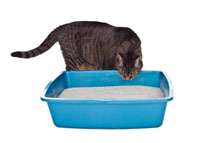Urinary System Blockage in Cats
If you suspect that your cat may have a urinary system blockage, meaning he cannot urinate, it is an emergency situation. Urinary blockage in cats occurs with something blocks a cat's urethera, the tube that carries urine from the bladder to the outside world. The condition is far more common in male than female cats because their urethras are more narrow.
Urinary blockage in cats occurs with something blocks a cat's urethera, the tube that carries urine from the bladder to the outside world. The condition is far more common in male than female cats because their urethras are more narrow.
Causes of Urinary Blockage in Cats
Complete blockage of the flow of urine out of the urethra is a very serious condition. This problem is a consequence of some of the conditions associated with feline lower urinary tract disease (FLUTD).
There are many causes of urethra blockage, but the two most common are stones and plugs. Mucous, crystals, and tiny bits of urinary debris (cells and protein) can aggregate together to form a soft, compressible material that can lodge in the urethra and completely block the flow of urine. These are plugs. Stones are mineral deposits that are hard and may or may not be round in shape.
Blockage is most common in male cats due to the fact that their urethra is longer and narrower than in female cats. Females can become blocked, though, but it is much more rare. Cats that are straining to urinate frequently and not producing urine may be blocked or just exhibiting these signs due to bladder discomfort associated with sterile interstitial cystitis, or bladder infection; other types of conditions we classify as FLUTD complex.
Signs of Urinary Blockage in Cats
A blocked cat may exhibit some or all of the following signs:
- No urine produced
- Straining in the box
- Blood or crystals in the fur at the back end where the urine comes out
- Lethargy, hiding, inactivity, aggression, restlessness, crying, pacing
- Vomiting
- Swollen, hard tummy
- Loss of appetite
- Small amounts of urine +/- blood in the box or elsewhere in the home.
If the blockage lasts for greater than a day, death can result from the buildup of toxins.
Kidney failure or burst bladder may occur.
If you have not been checking the box daily, if your cat goes outdoors, or if you have a multi-cat household, it may be tough to tell exactly when he last urinated, but do your best. See the signs above, and if in doubt, it is essential that you seek veterinary attention for your cat immediately.
Treatment of Feline Urinary Blockage
With simple palpation of the abdomen, the veterinarian can usually quickly determine whether the urethra is blocked.
Although, on occasion, gentle pressure by the veterinarian on the bladder can expel the obstruction and relieve the blockage, usually a urinary catheter will be required. The passage of the catheter into the bladder requires sedation or light anesthesia unless the patient is near death. Although most of the them, the catheter can be inserted, occasionally the stone or plug is so tightly lodged within the urethra that the urinary catheter cannot be passed. Flushing may be done to help move it out back into the bladder.
If male cats develop repeated episodes of this condition, a surgery called “ perineal urethrostomy” will be performed to permanently change the size of the outflow tract to make it less likely a stone or plug can become stuck. In this surgery, the urethra is shortened and widened making him more like a girl cat anatomically. The male cat will then urinate from an opening in the skin below the anus rather than out of the penis.
The surgery may not prevent subsequent bouts of blockage and may slightly predispose the cat to bladder infections. This is life-saving surgery, though, since repeated bouts or intractable blockage will lead to death of the cat.
If the bladder was very over-distended during blockage, some damage to the bladder wall may have occurred, and only time will tell whether the muscles that produce normal emptying and squeezing down of the bladder will recover. Rarely, if extremely over-distended, tears can occur in the wall of the bladder, requiring surgical repair in another type of surgical procedure.
Once the obstruction has been relieved, cats will require at least a few days stay in the hospital. The urine is analyzed and cultured (to see if the urine contains bacteria) and antibiotics will be started if needed. Intravenous fluid therapy is provided because most blocked cats have dangerous levels of toxins in the blood and bloodstream electrolyte imbalances that need to be corrected. This is due to the urine backing up into the kidneys, resulting in temporary and sometimes permanent kidney dysfunction.
The veterinarian will leave the urinary catheter in place until it is less likely the cat will block again when it is removed. Spasms and pain will be attended to with medication, and sometimes tranquilizers are administered in order to relax an unhappy patient.
You May Also Like These Articles:
Polycystic Kidney Disease (PKD) in Cats
Feline Lower Urinary Tract Disease
Cat Not Using Litter Box? Inappropriate Urination in Cats
Quiz - Inappropriate Urination in Cats
General Tips for Solving Inappropriate Urination Problems in Cats
Notice: Ask-a-Vet is an affiliated service for those who wish to speak with a veterinary professional about their pet's specific condition. Initially, a bot will ask questions to determine the general nature of your concern. Then, you will be transferred to a human. There is a charge for the service if you choose to connect to a veterinarian. Ask-a-Vet is not manned by the staff or owners of CatHealth.com, and the advice given should not delay or replace a visit to your veterinarian.





